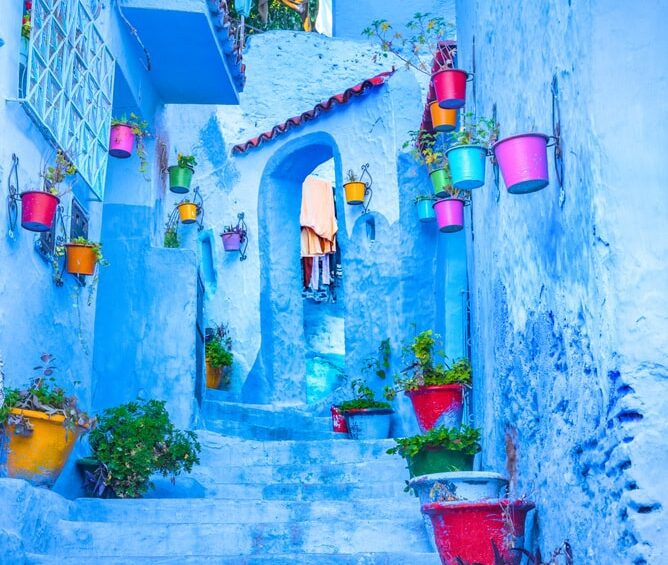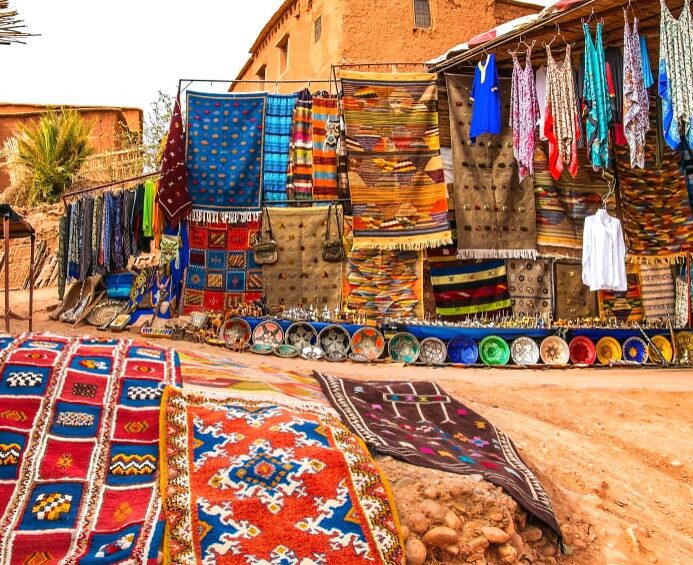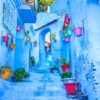why is chefchaouen blue
Chefchaouen is lovingly called the “Blue City” of Morocco. It’s famous for its blue-painted buildings and blue streets. This captivating beauty comes from the town’s history and cultural traditions. The indigo and cerulean colors make it a feast for the eyes. It’s a dream location for photographers.1 The town is located in the Rif Mountains, offering a beautiful and special place for all who visit.
Create an image of the blue buildings in Chefchaouen standing out against the green hills and white clouds in the background. The blue color should be the focal point of the image and convey a sense of peacefulness and serenity. The buildings should look weathered and textured, reflecting the town’s history and character.
Key Takeaways
- Chefchaouen is renowned for its vibrant blue-painted buildings and streets.
- The town’s captivating allure is deeply rooted in its history and cultural traditions.
- The indigo and cerulean hues create a visually stunning feast for the eyes.
- Chefchaouen is a scenic mountain retreat nestled in the foothills of the Rif Mountains.
- The town’s blue color was first introduced by Jewish refugees in the 1930s.
1 Day Trip From Fes To Chefchaouen (The Blue City)
The Captivating Allure of Chefchaouen’s Blue Walls
Chefchaouen’s blue buildings create a special, dream-like vibe. From the indigo-dyed walls to the cobalt blue doorways, it’s a stunning sight.23
Indigo Hues and Cerulean Shades: A Vibrant Feast for the Eyes
Chefchaouen sits in the Rif Mountains. It’s a lovely place with tightly packed houses and small, zigzagging streets amidst the mountains.23 The town combines natural beauty with incredible colors, making it truly entrancing.3
A Scenic Mountain Retreat in the Foothills of the Rif Mountains
Known as “Morocco’s blue pearl,”3 Chefchaouen is a beautiful sight. The blue buildings and blue streets stand out against the mighty Rif Mountains.23
The History and Origins of Chefchaouen’s Blue Tradition
In the 1930s, Jewish people running from attacks in Spain and Portugal brought their unique blue traditions to Chefchaouen. They chose this color to honor their faith. It reminds them of the sky, heavens, and God’s might.1
Jewish Refugees and the Symbolism of Blue in Religious Tradition
When the Jews left for Israel in 1948, the town kept painting everything blue. This was to show respect and keep their tradition alive.1 There are other reasons suggested for choosing blue. It might have been to fight off mosquitos or to stay cool in the warm weather.4
Preserving the Legacy: Annual Repainting by Local Authorities
Founded by Moulay Ali Ben Moussa Ben Rached El Alami in 1471, Chefchaouen later became a part of Spain. It saw a big wave of Jewish residents during the Second World War.4 They left mostly in the late 1940s and early 1950s, moving to Israel. After Morocco won back its independence in 1956, Chefchaouen was again under Moroccan rule.4
Alternative Theories: Mosquito Deterrent and Natural Cooling
Soon after the city’s founding in the 15th century, it’s believed that the blue paint appeared. The Jewish area might have had more blue back then. In the 1930s, more blue showed up thanks to the influx of Jewish people.4
People say the blue keeps mosquitoes away and cools their homes. They also think blue represents the sea or the city’s waterfall. In Islamic tradition, blue is a symbol of joy and hope. Painting Chefchaouen in blue has also made it a favorite spot for tourists.4
Chefchaouen is situated 600 meters above sea level. Its exact location is at 35°10′17″N 5°16′11″W. In 2014, it was home to 42,786 people. This city is part of the UNESCO Global Network.5
why is chefchaouen blue
Chefchaouen’s trademark blue comes from its Jewish roots. In the 1930s, Jewish people fled Spain and Portugal, settling here. They brought the custom of using blue threads in their prayer shawls.
1 This was a way to symbolize the sky and show respect to God’s power with color.6 The town’s buildings and streets soon reflected this tradition. And so, Chefchaouen’s blue look was born, making it stand out.
The Jewish Connection: Weaving Blue into Prayer Shawls
Back in the 1930s, Jewish refugees added blue threads to their tallits in Chefchaouen. These threads symbolized the sky and heaven. Using blue honored the power of God through color.
Honoring the Heavens and God’s Power through Color
Chefchaouen’s blue buildings represent a deep Jewish tradition. They reflect the heavens and symbolize God’s strength. This choice of blue is significant in the Jewish faith, connecting the town’s look to its beliefs.6
Exploring Chefchaouen’s Enchanting Medina
Walking through Chefchaouen’s blue medina is super engaging. It’s easy to get lost in the deep blue alleys and streets. Here, you’ll find souks selling many traditional items, from rugs to leather goods.7 Spending time here, taking photos, and checking out the sights is a must. Plaza Outa el Hammam is a key place, known for its cafes and restaurants.
Navigating the Maze of Blue Alleys and Souks
As you explore, you’ll see beautiful doorways and arches. Plus, don’t be surprised to meet some friendly cats. This adds to the town’s lovely feel.7 People like shopping in Chefchaouen because of the good deals and the calm shopping vibe. This is different from busier spots in Morocco, like Fes and Marrakech.
Picturesque Doorways and Local Feline Companions
Walking the medina lets you really soak in Chefchaouen’s lively culture.7 There are several places to stay in the medina, like Lina Ryad and Spa. They offer cool things like indoor pools and traditional Moroccan style.
Architectural Gems and Cultural Landmarks
Chefchaouen’s architectural heritage shines through iconic buildings and cultural spots. The8 Kasbah Museum, set in a former sultan’s palace, lets visitors explore the town’s deep history. It features displays that date the area’s story all the way back to ancient times.8
The Kasbah Museum: A Window into Chefchaouen’s Rich History
The Kasbah Museum is a key spot for those who love chefchaouen architecture and its cultural spots. Inside a past sultan’s home, it shows Chefchaouen’s earlier days. You’ll see how the area has changed over the centuries through interesting displays.8
The Spanish Mosque: Panoramic Views and Sunset Splendor
The Spanish Mosque is high on a hill, giving amazing views. From there, you can see the town, the Rif Mountains, and experience beautiful sunsets. Its unique minaret and exceptional views during9 sunset make it a favorite place for visitors and locals.8
The Kasbah Museum and the Spanish Mosque highlight Chefchaouen’s cultural gems. They offer a look into the town’s history and amazing views. This makes Chefchaouen’s unique4 past and natural beauty stand out to visitors.98
Beyond the Blue: Outdoor Adventures in Chefchaouen
Chefchaouen is famous for its blue buildings, but it’s also a hub for outdoor lovers.10 Here, hikers can journey through the Rif Mountains. They’ll encounter stunning natural sights like waterfalls and narrow gorges.10 The area’s famous Talassemtane National Park is rich with diverse plants and animals. This includes otters, monkeys, and many bird species.10 These adventures balance the town’s cultural and architectural wonders.
Hiking the Rif Mountains and Discovering Natural Wonders
The Rif Mountains stand tall around Chefchaouen, creating a perfect playground for outdoor fans.10 Exploring this rough landscape reveals beautiful waterfalls and deep gorges.10 These hikes let you soak in the area’s stunning natural beauty. They connect you with the peaceful outdoor environment that enhances Chefchaouen’s lively blue-hued scenes.
Talassemtane National Park: A Biodiversity Hotspot
The Talassemtane National Park is a short drive from Chefchaouen and a top spot for nature lovers.10 Within this protected site is a wealth of plant and animal life. This includes the rare Barbary macaque, otters, and many bird types.10 Walking its green forests and rugged landscapes lets you see its incredible natural wonders. It’s a must-see part of the exciting chefchaouen outdoor adventures.
Aerial view of Talassemtane National Park with snow-capped mountain peaks in the background and a winding river flowing through the lush green forests.
Chefchaouen’s Vibrant Traditions and Local Crafts
Chefchaouen stands out with its bright blue buildings and unique culture. It’s famous for making thick, woolly blankets and big, warm socks, great as souvenirs. These items show the town’s cultural past, which goes back over 500 years.11
Woollen Blankets and Hand-Knitted Socks: Iconic Souvenirs
Exploring the markets and workshops in Chefchaouen lets visitors see its vibrant culture. Artisans create beautiful woollen blankets and comfy socks by hand. These items are not just souvenirs; they’re a window into the town’s deep cultural roots.11
Savoring the Flavors: Goat’s Cheese and Moroccan Delicacies
Chefchaouen is also known for its tasty food. People can enjoy fresh goat’s cheese, a local favorite, at markets or for breakfast. Tasting this cheese and other Moroccan dishes is a tasty way to learn more about the town’s culture.11
Planning Your Visit to Chefchaouen
The best time to visit Chefchaouen is between May and September. The weather is mild then, making it very nice to explore.12 But, it gets crowded during Holy Week from Spaniards. This happens between Palm Sunday and Easter.
Best Time to Visit and Weather Considerations
Chefchaouen is nestled in the Rif Mountains, enjoying mild weather. Winters are around 18°C, while summers reach 28°C.13 The best times to visit are in spring and fall. The climate is perfect, and there are fewer tourists.
Getting to Chefchaouen: Transportation Options
To reach Chefchaouen, buses are available from cities like Tangier, Fez, and Casablanca.12 The closest international airport is in Tétouan, 30 miles away. It connects to European cities too.13 Taxis are another option, ensuring a quicker but pricier journey.14
Planning your visit well is key for a smooth trip to Chefchaouen. With its blue charm, the city captivates all year round. It promises a memorable travel experience.
Show a vibrant blue tuk-tuk or bike rickshaw navigating the winding streets of Chefchaouen, passing by colorful doors and windows, with the Rif Mountains in the background.
Conclusion
Chefchaouen is known as the “Blue City” of Morocco. It’s a special place that draws you in with its bright colors, deep history, and the beauty of nature around it.12 You’ll see streets and stairs in shades of blue. And you can also enjoy hiking in the Rif Mountains. This city mixes old traditions, beautiful buildings, and outdoor fun in a way that’s truly unique.15 It’s perfect for anyone who loves taking pictures, learning about new cultures, or trying different activities. Chefchaouen will definitely make a strong memory for anyone who visits.
Chefchaouen is just a 2-hour drive from Tangiers12. It sits at 560 meters above the sea15. The whole town is painted in beautiful blue shades, making it stand out in Morocco12. Tourism is very important here, giving visitors a chance to enjoy the local ways, food, and the great outdoors.
If you’re looking for amazing photos, to learn about the town’s history, or to hike in the mountains, Chefchaouen is perfect.12 But, remember that parking is hard to find in the old town. And not many hotels have their own parking12. So, it’s smart to plan how you’ll get there and where you’ll stay to really enjoy your time in this special “Blue City”.
FAQ
Why is Chefchaouen, Morocco, known as the “Blue City”?
Chefchaouen gets its name, “Blue City,” from the bright blue colors all around. Its buildings and streets shine in these vibrant blues. The custom started in the 1930s. Jewish refugees added these blues to their prayer shawls, showing the sky and heavens.
What is the cultural significance of Chefchaouen’s blue-painted buildings?
Chefchaouen’s blue buildings carry a deep meaning, tied to the Jewish tradition. They painted their houses blue to reflect the sky and God’s power. This practice has carried on, even though the Jewish community left in 1948. Every year, the town’s buildings get a fresh coat of blue, keeping this tradition alive.
What are some of the notable landmarks and cultural sites in Chefchaouen?
The town boasts the Kasbah Museum, set in an ancient palace, showcasing its history. And the Spanish Mosque, on a hill, offers stunning views of Chefchaouen and the Rif Mountains, especially at sunset.
What outdoor activities can visitors enjoy in Chefchaouen?
For nature lovers, the Rif Mountains are perfect for hiking, with many scenic spots like waterfalls and gorges. The nearby Talassemtane National Park is a must-see, known for its diverse wildlife and plant life.
What are some of the unique local crafts and culinary offerings in Chefchaouen?
The town is famous for making thick blankets and warm socks that are wonderful souvenirs. Also, don’t miss trying the local goat’s cheese, a favorite on breakfast tables.
When is the best time to visit Chefchaouen, and how can visitors get there?
It’s best to visit from May to September for the mild weather. Visitors can get there by bus from cities like Tangier, Fez, and Casablanca. The closest international airport is in Tétouan, only 30 miles away, serving flights from Europe and within Morocco.












